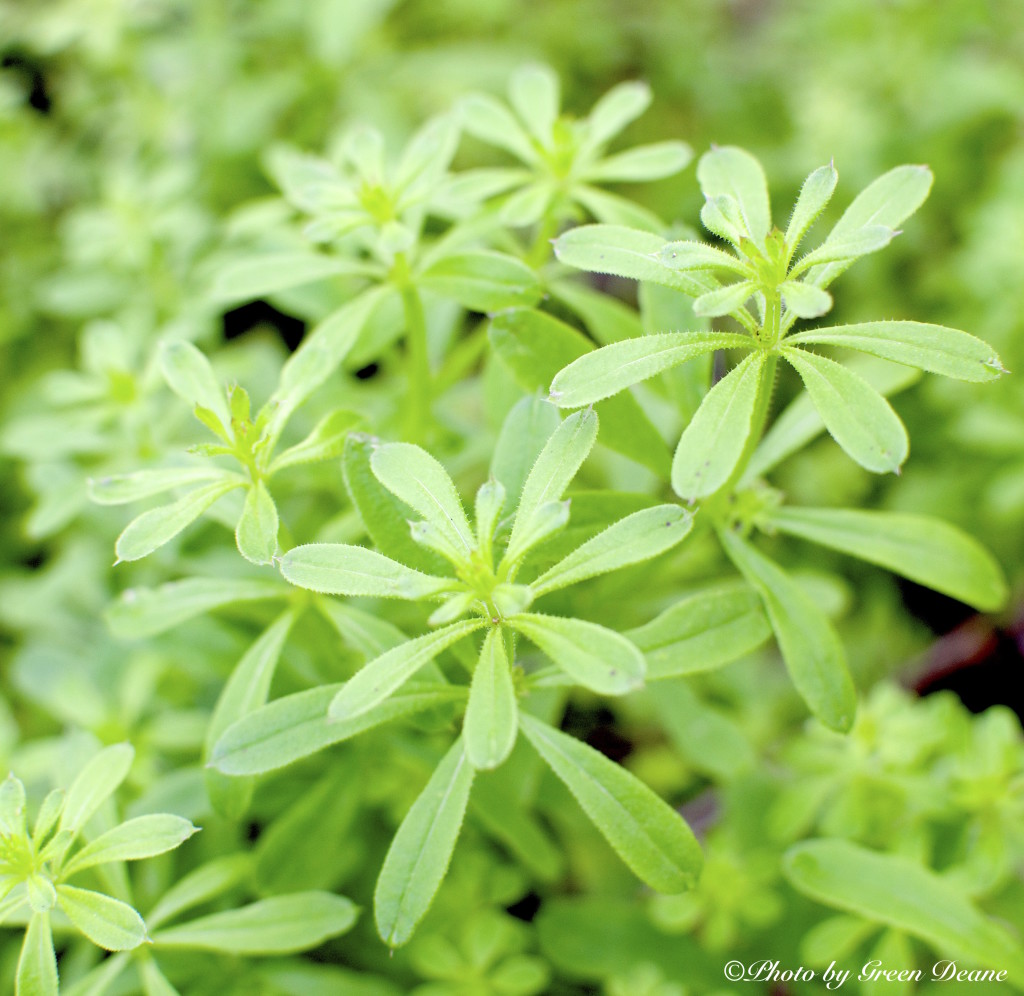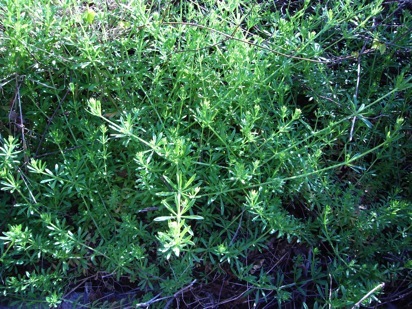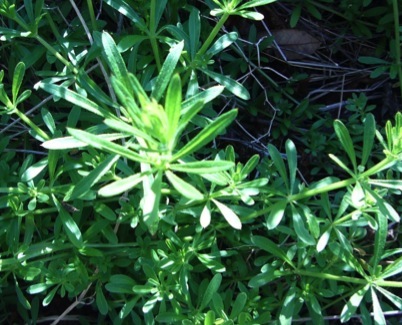You don’t find Goosegrass. It finds you.
Covered with a multitude of small hooks, Goosegrass, Galium aparine (GAY-lee-um ap-ar-EYE-nee) clings onto almost everything it touches. In fact, it clings so well you don’t have to take a bag with you to collect it. I usually just grab a bunch and touch it to my back pack. Instant stick. Indeed, the real headache with Goosegrass (aka Cleavers, Bedstraw, Stickywilly) is cleaning it of debris. It hates to let go of anything (which means a ball of it makes a good sieve.)
Young tips raw or boiled 10 to 15 minutes make an excellent green and the seeds roasted are one of perhaps two plants that actually makes a coffee-tasting coffee substitute (without caffeine.) Galium is in the same greater family as coffee. Older plants become laced with silicon and are too tough to eat, though I wonder if they would yield a lubricant of sorts.
Goosegrass is so called because geese love it along with most farm fowl and livestock. It is not, however, welcomed everywhere. Its seed are prohibited or restricted in Connecticut, Massachusetts, New York, and Vermont. Kentucky calls it a threatening weed. The Canadian provinces of Alberta, British Columbia, Manitoba, and Saskatchewan list it as a noxious weed. Why not just call it lunch? There are no noxious weeds in countries that are starving.
Botanically Galium aparine means” milk seizer.” Juice from another member of the genus, Gallium verum, was used to curdle milk for cheese making. Galium comes from the Greek word γάλα (GAH-la) meaning milk. Aparine is from the Greek verb απράζω (ap-RAH-zoh) meaning to seize. Greek shepherds would use Goosegrass as a strainer for milk and other things. As a strainer you can bunch it up or make crosshatched layers.
Other colloquial names include: Clivers, Barweed, Hedgeheriff, Hayriffe, Eriffe, Grip Grass, Hayruff, Catchweed, Scratweed, Mutton Chops, Robin-run-in-the-Grass, Loveman, Tongue Bleed, Goosebill, and Everlasting Friendship. The ancient Greeks called it philanthropon, “man loving” from its clinging nature. It’s a fun plant to introduce to kids because it sticks to their clothes.
Actually four Galiums are used somewhat regularly. Besides curdling milk the Galium verum’s blossoms were used for coloring and scenting cheese and butter with a honey-like fragrance. The flower tops are also used to make a refreshing drink. Galium mollugo, White Bedstraw, Revala, is one of 56 leaves added to a ritual dish in Friuli, Italy, and is now naturalized in the eastern US, the northwest but not the Deep South. Galium odoratum is used for flavoring fruit cups and German Maywine. It is found in a hodge-podge of places in North America, part of the eastern US and Great Lakes area, part of the northwest, and Colorado. Check a USDA map for your area. The dried leaves are a tea substitute and the flowers are eaten or used as a garnish. Also listed has having edible leaves are: Galium boreale, Galium gracile, Galium spurium, and Galium triflorum. There’s also about a dozen endangered species, most of them in California. So, carefully identify your local Galium.
As one might guess the genus has been used for medicinal purposes. Dried Galium verum has some coumarin in it and has been used to treat bladder and kidney problems including stones as well as dropsy and fever. It also has citric acid (which makes it refreshing as a drink) and that might have anti-tumor activity. Some think it lowers blood pressure and is anti-inflammatory. It can also prevent scurvy. Native Americans used Galium pilosum to prevent pregnancy. Goosegrass also strengthens your immune system and is good for you lymph system. During WWII children in Britain were paid to harvest Goose Grass (and other medicinal herbs.) It was used by pharmaceutical companies to make medicine to combat infections.
Galium triflorum and Galium uniflorum were used for the flu and as a diuretic. The Cherokee used Galium circazans for coughs, hoarseness, and asthma. For respiratory problems the Ojibwa used Galium tinctorium. Galium triflorum was the most used medicinally. They used it as in infusion for gallstones and a poultice to reduce swelling. The ladies also used it as a perfume and for washing hair. The root of the Galium tinctorium was also used for a red dye.
Locally, that is in central Florida, two Galiums are common, the Galium aparine and Galium tinctorium. They are fairly easy to tell apart. Galium aparine, the for-certain edible, has six to eight leaves in a whorls at a node. It prefers dry areas. Its white flowers have four petals. The Galium tinctorium, the smaller of the two, has four to six leaves in a whorl and likes damp places. Is white flowers have three petals (sometimes four.) While it would be nice if the Galium tinctorium were edible I have found no reference that says it is. If you know otherwise please let me know.
Green Deane’s “Itemized” Plant Profile
IDENTIFICATION: Galium aparine: A weak square stem plant covered with little hooks that bend back towards the bottom of the plant. Feels scratchy and will cling to almost any texture. Leaves small and skinny, usually in a whorl around the stem, eight leaves at a time, lowest leaves petioled and roundish; upper leaves sessile, narrowly oblanceolate. Minute four petal-white flowers on small stalks where leaves meet the stem (axils). Fruit a tiny two-lobed capsule, covered with fine hooks.
TIME OF YEAR: May to July in northern climes, early March in Central Florida.
ENVIRONMENT: A wide variety, rich moist ground to upland scrub, woods, thickets, waste ground beside trails.
METHOD OF PREPARATION: Young shoots and or tip of older plants raw or boiled 10/15 minutes. Serve warm with butter or olive oil, sale and pepper. Or, let them cool and use them in a variety of ways, salads, omelets et cetera. Slow-roasted (low temperature) roasted ripe seeds when ground make a good coffee substitute without caffein. Older plans are not edible. Look for new growth in spring.
According to Professor Gordon Brown, Goosegrass is good for the lymph system.




